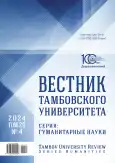The Artists’ Association branches of Revolutionary Russia: experience of interaction with regions
- Authors: Bakaryagin S.S.1
-
Affiliations:
- P.G. Demidov Yaroslavl State University
- Issue: Vol 29, No 4 (2024)
- Pages: 1087-1094
- Section: NATIONAL HISTORY
- URL: https://ogarev-online.ru/1810-0201/article/view/297800
- DOI: https://doi.org/10.20310/1810-0201-2024-29-4-1087-1094
- ID: 297800
Cite item
Full Text
Abstract
Importance. The activities of the Artists’ Association branches of Revolutionary Russia (1922–1932) are considered. During this period, the organization had a significant and sometimes decisive place in the artistic life of the country. The subject of the study relates to the culture of the country as a whole and touches on local history issues. The purpose of the work is to assess the influence of the central organization on the local branches development and analyze their importance in the Association work.Materials and Methods. The research is based on materials from the Russian State Archive of Literature and Art, the State Archive of the Yaroslavl Region and published memoirs of participants in the events. In the course of the work, the biographical method is used, as well as historical-genetic and historical-comparative methods traditional for historical science.Results and Discussion. It is noted that the Association participants paid great attention to the creation of representative offices at the local level. The presence of artistic traditions in a particular region played an important role in the development of local branches of the AARR. At the same time, established traditions are not the determining factor. The presence of a bright creative personality in it, who set a certain pace of work, could be of significant importance in the development of a particular branch.Conclusion. It is revealed that some of the regional branches ceased their activities even before the liquidation of the AARR. Despite this, the work of branches of the Artists’ Association of Revolutionary Russia contributed to the accessibility of art for the local population, attracting regional residents to artistic life and preserving cultural monuments. Museums and creative studios are created, and active exhibitions and lectures are carried out.
About the authors
S. S. Bakaryagin
P.G. Demidov Yaroslavl State University
Author for correspondence.
Email: stepan280694@yandex.ru
ORCID iD: 0000-0002-2563-4312
Research Scholar of Modern Russian History Department
Russian Federation, 14 Sovetskaya St., Yaroslavl, 150003, Russian FederationReferences
- Ioganson B.I. (2016). AKHRR. Assotsiatsiya khudozhnikov revolyutsionnoi Rossii. Moscow, BukSMArt Publ., 128 p. (In Russ.)
- Bogorodskii F.S. (1959). Vospominaniya khudozhnika. Moscow, Sovetskiy khudozhnik Publ., 387 p. (In Russ.)
- Severyukhin D.Ya., Leikind O.L. (1992). Zolotoi vek khudozhestvennykh ob”edinenii v Rossii i SSSR (1820–1932). Spravochnik. St. Petersburg, Chernyshev Publ., 400 p. (In Russ.)
- Gronskii I.M., Perel’man V.N. (compilers). (1973). Sbornik vospominanii, statei, dokumentov «Assotsiatsiya khudozhnikov revolyutsionnoi Rossii». Moscow, Izobrazitel’noe iskusstvo Publ., 503 p. (In Russ.)
- Lobasheva I.F. (2020). Kazan art school and its heritage in the collection of the state museum of fine arts of the Republic of Tatarstan. Istoricheskaya Ehtnologiya = Historical Ethnology, vol. 5, no. 3, pp. 362-372. (In Russ.) https://doi.org/10.22378/he.2020-5-3.362-372, https://elibrary.ru/dxwxsn
- Golenkevich N.P. (2002). Khudozhestvennaya zhizn’ Yaroslavlya kontsa XIX – pervoi treti XX stoletiya: tvorcheskie ob”edineniya, vystavki, khudozhniki. Moscow, 109 p. (In Russ.)
- Shestakova T.N., Salyakhova E.I. (executive eds.) (2008). Sbornik statei «Khudozhniki i Tambovskii krai v XX veke». Tambov, Tambov State Technical University Publ., 94 p. (In Russ.) https://elibrary.ru/qrlcjj
- Manin V.S. (2008). Iskusstvo i vlast’: bor’ba techenii v sovetskom izobrazitel’nom iskusstve 1917–1941 godov. St. Petersburg, Avrora Publ., 384 p. (In Russ.)
Supplementary files









